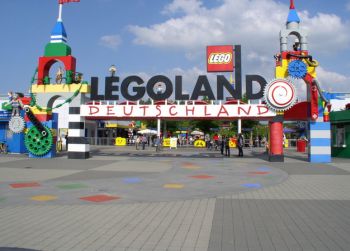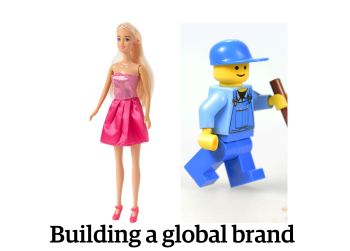
The recent release of the Barbie movie has generated discussion in the business world. Love her or hate her, the woman with hundreds of careers, as many looks, and impossible body shape has endured for over 60 years. As a brand she is a globally recognised icon.
Ditto LEGO®. Loved by kids and many adults, hated by anyone who has stood, barefoot on those hard, lumpy bricks scattered across the carpet, LEGO® is a global phenomena.
One is American, the other Danish. Both have survived attempts at imitation. Both have spawned movies and merchandise. In the case of LEGO®, there are international theme parks in the form of Legoland whilst Barbie had her own Barbie themed cruise. A Mattel Adventure Park, featuring Barbie along with other products from the Mattel stable, is due to open in Arizona in 2024.

In Wellington at the moment, you can find the Jurassic World exhibition at Tākina featuring 6 million LEGO® bricks, plus the Barbie Collector exhibition on at Wellington Museum. Both are proving crowd pleasers. Here at Wellington City Libraries there are LEGO® building sessions for enthusiasts aged 5-105. (Check the Libraries’ Event calendar).
Why are both these products so popular? In this week’s blog we look at what’s the secret to the global domination and enduring longevity of LEGO® and Barbie.

Barbie
Who created Barbie? Ruth Handler faced sexism that would feel familiar to women leaders today
This article from FastCompany outlines the history of Barbie, and the marketing thinking behind the brand.
How to Save an Iconic Brand. Feifer, J. Entrepreneur. 2022;50(8):11-16. Accessed July 24, 2023. Barbie dolls have been one of Mattel’s top-selling products for decades. In this article former Mattel executive Richard Dickson explains that “while evolution makes a brand relevant, purpose makes a brand immortal.”. [Library registration required to access]
The Toys That Built America
Season 1 (2021)
Against the backdrop of major events in American history like the Civil War and the Great Depression, “The Toys that Built America” shares a different story—one that brings new products and nostalgic toys to the forefront as driving forces behind untold cultural and economic shifts. The four-part docuseries showcases visionaries such as the Parker Brothers, Milton Bradley and Ruth Handler who transformed a small toy company into the billion-dollar empire now known as Mattel®. It reveals the little-known stories behind groundbreaking innovations like the Frisbee® and accidental discoveries like how the Slinky® was created. Additionally, the docuseries unveils competitive rivalries between iconic brands that changed the fabric of our nation forever. Blending dramatic reenactments and archival footage with interviews from experts, biographers, and others, “The Toys That Built America” brings to life the surprising tales of the men and women who created some of America’s most beloved and enduring toys, including Silly Putty®, Monopoly®, Barbie®, G.I. Joe®, and other famous classics. [Available on the Kanopy streaming platform. Library registration required]
The Economics of Barbie: Marketing the Evolution of an Icon Through the Generations. Roberts DL. Journal of Applied Business & Economics. 2020;22(7):83-88. doi:10.33423/jabe.v22i7.3253
Analyses the continued success of the Barbie doll and how it has remained relevant over the years. Market analysts attribute Barbie’s long-term success to her responsiveness to evolving styles and adaptability to changing trends in American society.
Dressing Barbie : a celebration of the clothes that made America’s favorite doll, and the incredible woman behind them / Spencer, Carol
“Illustrated with more than 100 full-color photographs, including many never-before-seen images of rare and one-of-a-kind pieces from Carol Spencer’s private archive. A treasure trove of some of the best and most iconic Barbie looks from the early 1960s until the late 1990s.” (Catalogue)
A Barbie for Every Body. (cover story). Dockterman E. TIME Magazine. 2016;187(4):44-51. Accessed July 24, 2023.
Looks at how Mattel expanded the Barbie doll range to take in differing body shapes. Looks at the evolution of Barbie through the ages. [Library registration required to access]
Barbie’s Secret Plan For World Domination. Goldstein L. Fortune. 1998;138(10):38-40.
An older article that looks at Mattel’s Barbie-related marketing. The Barbie doll’s United States market penetration; Children’s garments that will offered with the Barbie brand; Merchandise that will be launched in connection to the toy’s 40th anniversary; Plans for Barbie stores in New York City and Los Angeles, California. [Library registration required to access]
LEGO®
Brick by Brick. Kiefer, B. July 2023:22-30. Accessed July 24, 2023.
Presents an interview with Julia Goldin, Chief product and marketing officer for the Lego Group. Through product innovation, creativity and inclusive marketing, she has helped steer Lego from “being not just the definitive toy brand for children, but also now an entertainment brand, loved by everyone” [Library registration required]
Lego, the world’s top toymaker, focuses on China. The Economist, 6 May 2023, p. NA. Gale In Context: Global Issues, Accessed 24 July 2023.
Examines Lego’s expansion into the Chinese market where the Chinese name for Lego, Legao, includes the character for happiness. [Library registration required]
Innovation-driven culture: Developing a culture that prioritizes innovation is the key to creating long-term sustainable value. Frigo, ML, Groff ET, Snellgrove D. Laessoe H. Strategic Finance. January 2023:21-24. Accessed July 24, 2023.
The article explores innovation culture as a means to create long-term sustainable value by companies and presents insights from business leaders on creating an innovation-driven culture. Hans Laessoe of the Lego group shares insights into developing an innovation culture. [Library registration required]
“The extraordinary inside story of the LEGO company–producer of the most beloved and popular toy on the planet–based on unprecedented access to the founding family that still owns the company, chronicling the brand’s improbable journey to become the empire that it is today”– Provided by publisher.” (Catalogue)
The Lego story: remolding education policy and practice. Pirrie A. Educational Review. 2017;69(3):271-284. doi:10.1080/00131911.2016.1207614
The aim of this article is to develop a more nuanced understanding of the complex nature of learning as it relates to both the educational and social aims of education as manifested in contemporary European education policy. The article explores tensions in education policy and practice by exploring the evolution of the global brand Lego. The development of Lego is considered to be emblematic of attempts to renegotiate the relation between playing and studying; process and mastery; cognition and embodiment. …Lego serves as an analogy for the progressive realignment of linear and teleological views of knowledge and the coming into presence of the individual in community that is central to education in relation to contemporary European educational policy. [ABSTRACT FROM AUTHOR] [Library registration required]
Strategic risk management at the LEGO Group. Frigo ML, Laessoe H. Strategic Finance. 2012;93(2). Accessed August 1, 2023.
Describes strategic risk management at the LEGO Group, which is based on an initiative started in late 2006 and led by Hans Laessoe, senior director of strategic risk management at LEGO System A/S. It’s also part of the continuing work of the Strategic Risk Management Lab at DePaul University, which is identifying and developing leading practices in integrating risk management with strategy development and strategy execution. [Library registration required]
A LEGO brickumentary
“Since the birth of their trademark toy in 1958, The LEGO Group has produced over 400 billion bricks. But more and more, LEGO bricks aren’t just for kids, and some take them very seriously. Adult Fans of LEGO around the globe are unashamedly declaring their love of the brick, brick artists are creating stunning and surprising creations, and LEGO master builders are building human scale and larger structures. This documentary playfully delves into the extraordinary impact of the LEGO brick.” (Catalogue) [DVD]
The cult of LEGO / Baichtal, John
“The LEGO brick may be the most popular toy in the world, but it’s much more than just a toy. In The Cult of LEGO, John Baichtal of MAKE Magazine and Wired’s GeekDad blog and Joe Meno of BrickJournal take readers on a story-packed adventure through the history of LEGO, from its humble beginnings in a small Danish village to its ascent to the summit of the toy world. Along the way, readers are immersed in the fascinating world of LEGO and its fans. They learn hundreds of obscure LEGO facts as they’re surrounded by countless fantastically complex and challenging models built by some of the most famous adult LEGO builders. Both deep and wide-ranging, The Cult of LEGO is sincere, admiring, and encyclopedic in its coverage, surveying everything from gigantic models to robots to genuine works of art. Exhaustively researched and lavishly illustrated in full color, The Cult of LEGO is destined to be the definitive guide to LEGO fan culture”– Provided by publisher.” (Catalogue)
Building a global brand
Good to great : why some companies make the leap … and others don’t / Collins, James C.
[Looks at] How can good companies, mediocre companies, even bad companies achieve enduring greatness. Are there those that convert long-term mediocrity or worse into long-term superiority. If so, what are the distinguishing characteristics that cause a company to go from good to great. Over five years, Jim Collins and his research team have analyzed the histories of 28 companies, discovering why some companies make the leap and others don’t. The findings include: Level 5 Leadership: A surprising style, required for greatness. The Hedgehog Concept: Finding your three circles, to transcend the curse of competence. A Culture of Discipline: The alchemy of great results. Technology Accelerators: How good-to-great companies think differently about technology. The Flywheel and the Doom Loop: Why those who do radical restructuring fail to make the leap. Built to Last, the defining management study of the nineties, showed how great companies triumph over time and how longterm sustained performance can be engineered into the DNA of an enterprise from the very beginning.(Adapted from Catalogue) Also available as E-Audio book
Great by choice : uncertainty, chaos, and luck : why some thrive despite them all / Collins, James C.
“Enumerates the principles for building a truly great enterprise in unpredictable, tumultuous and fast-moving times.” (Catalogue)
A world of difference : leading in global markets with cultural intelligence / Menzies, Felicity
“Companies and organisations that have a diverse workforce benefit from increased innovation, creativity, performance and a better bottom line. However, building diverse teams in the workforce is not easy. Not everyone has the Cultural Intelligence (CQ) to work with people from other countries and cultures. Cultural Intelligence is not a personality trait, nor is it something you are born with. Rather, Cultural Intelligence develops through education, training, and experience. A good place to start to find out more about CQ is Felicity Menzies’ new book ‘A World of Difference.’ Filled with a mix of anecdotes drawn for the author’s personal experiences and research on this topic, Menzies helps leaders to understand Cultural Intelligence and how it can give them an enviable competitive advantage. Companies with leaders and workers who have high Cultural Intelligence are more agile. These organisations can quickly adapt processes, products, and services to capture new opportunities and respond to change across diverse markets. Cultural Intelligence also promotes successful intercultural relations, both inside and outside the organisation. This improves business performance via enhanced innovation, increased workforce engagement, and more effective partnering.” (Catalogue)
If you need more information please contact the Prosearch team at the library. We can help you find information across a range of perspectives and resources. All enquiries are treated in confidence.


